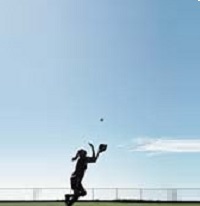
Playing outfield begins as soon as the outfielder arrives to the field. Here are some softball outfield tips for all outfielders. Before she even warms up, it is a good idea to check to see where the dugouts are, the condition of the fences, and the field conditions. How will the ball rebound off the fence ? If there is a warning track, how wide is it and where will the run end in trying to run down a deep fly ball. After the coaches or managers have their meeting at the plate, it is important to get the ground rules for doubles, home runs or regarding any potential obstacles such as goal posts that have not been removed from the field yet.
If it is a windy day, outfielders should be aware of how strong the wind is and if it is changing. This will effect how she sets up for fly balls and how she can anticipate the flight of the ball. This should be done every inning.
Outfielders should notice the direction of the sun and which direction it will be moving in. This will not only effect the ability to catch a fly ball but it can also effect the ability of the infielders to see a ball that is being thrown to them.
Softball Outfield Tips By Position
Left Field:
Covering:
Bases always need to be covered 2 bases ahead of the runner. So if there is a runner on first base and the ball is hit to the right side of the field, the left fielder needs to be able to cover third base if the shortstop is covering second and the third base player is pulled in. Basically any time there is a potential play at third, the left fielder needs to be prepared to take the base.
Backing Up:
- Balls hit to the left side of the field
- Balls hit to center field
- Throws to second base from the right side of the field
- Pick off throws to center fielder at second base
- Pick off throws to third base
Rundowns:
The coach will determine who is involved in the rundown. When there is a runner between home and third or second and third, the left fielder is either a back up player or takes part in the play. Depending on where the runner is, it may be infielders who participate in the play and outfielders who back up.
Center Fielder:
Covering:
Any time the shortstop and second base player are pulled away to first or third for example, the center fielder covers second base. This could be when there is a runner on first or third and the middle infielders need to cover those bases because first and third are drawn in to play the bunt.
If there is a surprise pick off throw from the pitcher on a runner who is not very quick getting back to the base, the Center fielder can sneak in on the bag for the throw.
Backing Up:
- Ball hit anywhere up the middle
- Balls hit to the left or right fielder
- Any throws to second base from anywhere in the middle of the infield
- The catcher’s throw to the pitcher
Rundowns:
As with the left fielder, the participation in a rundown depends on the way the team is set for rundowns. With a runner caught between first and second, or second and third the center fielder may be a back up while infielders execute the play. If there are other runners on base, the center fielder might be an active participant.
Right Fielder:
Coverage:
This rarely happens, but if a ball is hit to the left side of the field and the second base player is covering second, and the first base player has been pulled in, the right fielder would cover first base. This might happen with runners at second and third with a hit to left field. The pitcher needs to back up home plate, and the first base player needs to be the cut off player. There may not be a play at first but the right fielder needs to be there in case there is.
Backing Up:
- Balls hit on the right side of the field
- Balls hit to center field
- Throws to first base (guard the foul line)
- Throws to second base from the left side of the field
Rundowns:
The right fielder will most times be the back up player for a run down between first and second. If there is a runner on second or third however, 2 bases ahead of the runner need to be covered so the right fielder may need to participate in the rundown.
Experience
The ability to automatically go through checklists or make sure that covering and backing up is done correctly takes experience. Having a checklist to review is not a bad idea for outfielders so that they can review these tips between games or even just before. Like any other position, it takes a conscious effort to be able to retain the tips and to execute all of them correctly.
